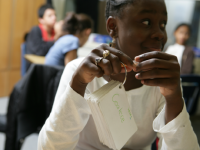Shared Mindfulness: Building Supportive Relationships in the Classroom
By pairing students to sit back to back and focus on their breathing, you can help them develop a sense of mutuality and social awareness.
No matter what subject we teach, all teachers share a common desire for more cohesiveness in the classroom. We know that when our students feel a sense of safety and belonging, trust their classmates, and know how to manage stress, learning is amplified. How can we help foster grounded confidence in our students among all of the many other tasks and responsibilities on our agendas?
One way is by giving students opportunities to connect mindfully with each other. The profundity of peer partnering is well known and extends far beyond the academic implications into the realm of social and emotional learning. Applying mindfulness to the equation allows students the possibility of developing peer relationships based on mutuality and social awareness.
Establishing Contact
This two-part activity first asks students to sit back to back with a peer while engaging in mindful listening and breathing. Then, students are encouraged to express their experience with their partners as a way of deepening their understanding of both the practice and each other.
The idea of asking students to sit with their backs touching may initially strike some teachers as precarious. Yet when approached with a great deal of trust in our students' humanity, we find that such activities can fill adolescents' deep need for social congruency. Further, working with a peer partner can even have an anchoring effect on mindful practices.
I've led students through this mindful activity in countless classrooms over the last 15 years -- both in dedicated yoga classes and as mindful relationship building in classes covering various subjects. Each time, I can feel a transformation. Students are more present. They listen more to their peers and their teachers. Meaningful interaction comes more easily.
To begin, have students sit back to back with a partner. Use what you know about your students to determine the most effective method of partnering, whether it's your call, their choice, or random pairing. Be sure that you are able to easily observe all sets of students, making special arrangements in the room if necessary.
First, attend to the physical components of students' posture. They should sit cross-legged such that their lower and upper backs, as well as the backs of their heads are in contact. Give ample time for students to find a balance point wherein there bodies are mutually supportive. The spine should be neither overly arched back or curved forward -- work for a naturally uplifted posture. Hands can be either placed in the lap or rested on the knees. Eyes can be softly closed or half closed with a gentle focus toward the floor a few feet ahead.
Breathing Together
Once students are settled in to their partner posture, which will take three to five minutes, ask them to pay attention to the sounds around them. In addition to priming the brain to focus, this step aids them in overcoming any feelings of vulnerability that may arise while beginning this activity with a partner. Instruct students to mentally note the sounds they hear. Allow another three to five minutes for this step, reminding them several times to simply listen for and label sounds.
Next, guide students to direct attention to their breathing. The following script provides an example:
- First, simply observe your breath. Breathe in and out through your nose. Watch your inhales, follow your exhales. Notice how your chest moves as you breathe. If it feels right to you, try deepening your inhales, slowing down your exhales.
- Now, begin to count your breath cycles. An inhale and an exhale equal one breath. Do this for two to three minutes. Notice when your mind wanders into other thoughts. Come back to your breath and begin counting again at one.
- Remember what number you are on and shift your attention from counting to feeling your partner's back. Can you feel your partner's back moving while he or she breathes? Are you breathing faster or slower than your partner? Can you direct your breath toward the back of your body, expanding the back of your rib cage as you inhale?
- For a few minutes, try to breathe in sync with your partner. When you notice your mind wander, come back to your breath.
- Now, let your breath come back to normal. Slowly open your eyes and turn to your partner.
Give students five minutes to share their experiences. Write the following three prompts on a board for discussion:
- What sounds did you hear?
- How many breaths did you count?
- Could you feel your partner's back moving as he or she was breathing?
As with any mindful practice, effectiveness dramatically increases when the teacher embodies the qualities of mindfulness. Perhaps you will find a fellow teacher or mate willing to try this practice with you several times prior to facilitating with your students.
